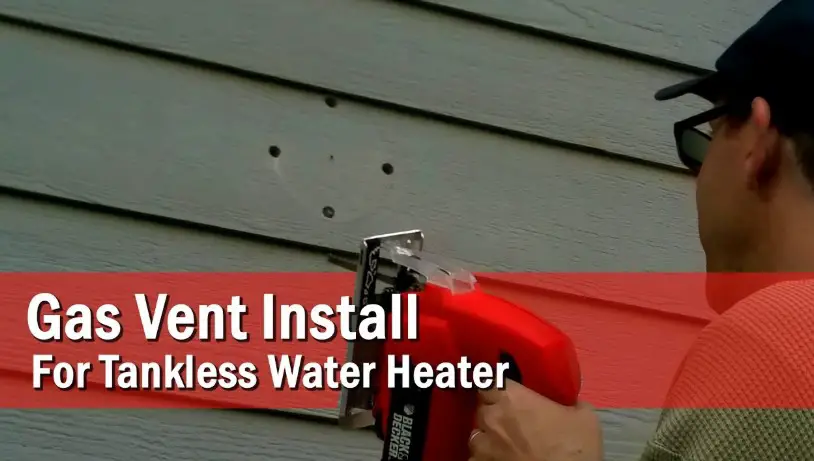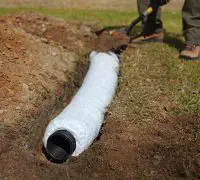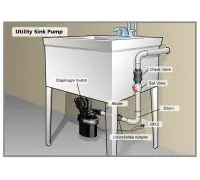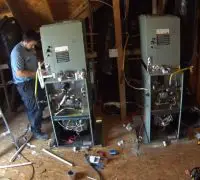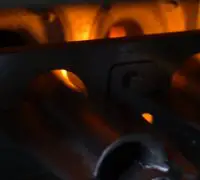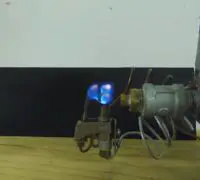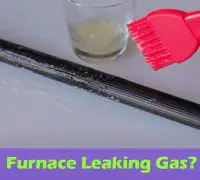If you're looking to fix or replace your Heating or A/C system, we can connect you with a reliable and cost-effective professional in your area.
Just because you have a gas-fired tankless water heater, doesn’t mean that you need venting. Obviously, you don’t require venting if your unit is installed outside, no matter if you’re using propane or natural gas. In the case of outdoor units, the exhaust is already out, so there’s no need for a vent.
It’s also apparent that electric tankless water heaters don’t need vent either. They don’t burn any fuel, and the heating element is heated by the coils that require electricity. There’s no exhaust emitted, therefore no need for a vent.
Page Table of Contents
Is it necessary to vent the gas tankless properly?
When the gas tankless water heater isn’t properly vented, many things can go wrong, and some of them are highly dangerous.
The exhaust is a gas condensate that has high acidity and corrosive properties to the venting. When the condensate doesn’t leave the vent correctly, running back into the heat exchanger, the tankless unit will fail sooner than expected.
In the case of the improper vent, the risk for carbon monoxide poisoning is very high. You must install the appropriate venting kit for your tankless water heater, following the specific instruction for your unit.
Should you consider power venting or direct vent?
In the case of gas tankless water heaters, there are two main categories of venting. Keep reading for the details
- Direct vent
The direct vent collects air from the outside, venting the exhaust out too. You can go with dual or concentric direct vent.
- The concentric vent kit comes with intake and outgoing in the same pipe. The exhaust is placed in the center, which is why the outside of the vent doesn’t heat up.
- The dual vent systems include two pipes, one with the exhaust and the other with the intake. The system has its limitations since it can get hot. You can only use PVC for sealing it.
No matter the type of vent, though, the direct vent system allows you to mount the tankless unit in small spaces.
- Power vent
The power vent features the intake on the body of the tankless heater. It collects the surrounding air, using the inside air for venting. The exhaust goes out of the house.
Since it requires a large area for proper functioning, the power vent has its limitations.
What tips to remember when installing the vent for your tankless water heater?
We should highlight once again that different gas-units come with different configurations and requirements in terms of the vent. However, there are some rules to follow when installing the vent for your gas tankless water heater, no matter the model or the brand:
- It doesn’t have to be through the roof
Conventional water heaters with tanks vent through the roof, but that’s not the case for the tankless units. The vent may end on a sidewall as the combustion fan exhausts from the water heater in a horizontal direction. It gives you more flexibility about the place of the unit. It’s easier to identify the site for a tankless water heater.
- Outdoor models don’t need venting
If you live in a warm region, it’s quite straightforward to mount a tankless water heater outdoor, with no need for venting. The tankless water heaters are made for taking below-freezing temperatures as they include features that reduce the risk of cracking and freezing.
- It’s not mandatory to mount it near a wall
For many recent construction scenarios, manufacturers include recess boxes for maintaining the tankless unit inside the wall. Non-condensing units are only 14-in wide, so they easily fit between regular studs. Since the condensing units are 18-in full, the framing is a bit more challenging.
- No need for metal venting for condensing units
Non-condensing water heaters can transfer to the water 80% of the heat they produce. Metal venting (thick aluminum or stainless steel) will be required due to the remaining heat. When we check the condensing units, we notice a 96% efficiency, whereas the temperature of the exhaust gas isn’t very high (110 or 120F degrees). It’s why you may vent them even with cheap plastic, with polypropylene and PVC as the most common options.
- Using several water heaters doesn’t necessarily mean multiple vents
The commercial and large residential applications may require you to install more than just one tankless unit. It doesn’t mean that you also have to install a vent for each and every water heater. For example, some manufacturers develop common-venting systems with a manifold. It’s used for sharing an identical exhaust and intake vents for a maximum of eight tankless water heaters. It’s a great feature to have when you don’t want to make too many holes through the walls for aesthetic or practical reasons.
- Venting systems shouldn’t be unattractive
Many people sit on the fence about installing vent purely for aesthetic reasons. However, numerous manufacturers took the artistic aspects when designing the venting systems. People often tankless water heaters for the subtle profile and vent may compromise the whole appearance, rending the installation to be useless from an aesthetic point of view. Nevertheless, many models come with nice looking pipe covers and termination points. Therefore, you cannot argue that the vent seems ugly. You no longer have any reasons for not installing venting.
Before you go away
Tankless water heater lets you have horizontal venting or up through the roof. You can use PVC or appropriate stainless steel piping for venting, with the little venting running as the best option. You should also look into Category III AL29-4C stainless steel because of the combustion leads to highly acidic condensate that damages the traditional vent materials.
Always stick to the manufacturer’s instructions when it comes to venting installation so that you get the best out of your water heater. When you vent the tankless unit correctly, you eliminate the risk for poor performance and accidents caused by gas or carbon monoxide. Installing proper venting is going to save you money and time in the long run, since the tankless water heater will get rid of expelling gases and condensate safely.
We can definitely connect you with a trusted provider in your area to repair, replace or maintain your heating and A/C systems. Why not let us find a professional for you?
